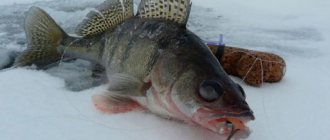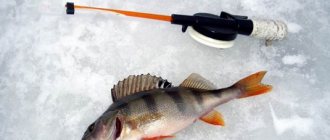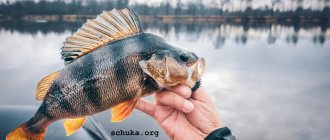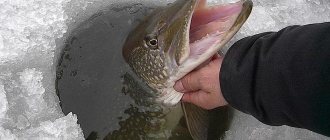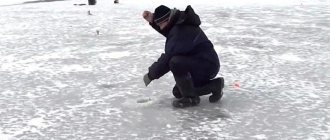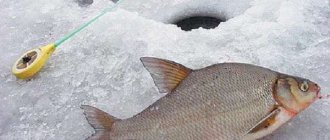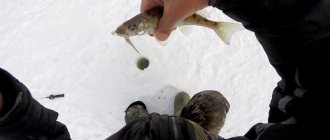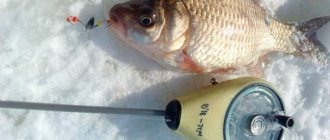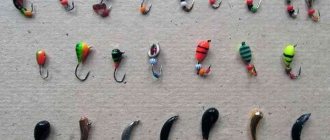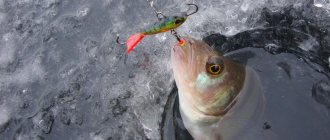Catching carp or grass carp from under the ice is a great success, but catching perch in winter on a balance beam is an exciting activity for all fishing fans, for whom neither snow nor frost is an obstacle. It’s not difficult to explain why exactly perch, because this restless predator, sometimes better, sometimes worse, bites throughout the year, giving great pleasure to anglers.
Perch constantly moves along rivers and lakes in search of food, regardless of whether the autumn sun is shining or the reservoir is covered with ice. And in the winter season, perch becomes the main prey of anglers and therefore gear and bait for catching it, in particular, balance beams, are especially popular.
Advantages of catching perch in winter using a balance beam
As you know, perch is a predatory fish and its diet includes animal components, but it reacts especially actively to the ubiquitous fry. Even in winter, when most aquatic inhabitants hibernate, small fish continue to move in search of food and become prey for predators.
Therefore, baits that at least vaguely resemble a small fish are especially effective when fishing from ice. The balancer is a bait that imitates a fry, equipped with a tee and two hooks in the head and tail.
The name of the bait is due to the fact that the artificial fish balances in the water during fishing, and when at rest it is located in a horizontal plane.
Advantages of catching perch using a balance beam in winter:
- The appearance of the bait resembles a live fish, the main prey of a predator.
- Active play during the retrieve, which the perch really likes and provokes it to bite.
- When using a balancer, a large area is fished, and on each hole.
- Even if a flock of predator is slightly to the side, he will definitely see and attack the bait.
- Imitation of the movement of a wounded fry seeking shelter.
- Possibility of search fishing mode, and this is important if it is not clear on what water horizon the perch is standing.
- The catchability of artificial fish, regardless of temperature and time of day.
- A variety of maneuvers that an angler uses when fishing with bait.
There are anglers who believe that a balancer is good when catching an actively moving predator, and when the perch is passive, vertical spoons show the best results. But practice shows that this is not the case, and even in the dead of winter the predator reacts to this bait; the main thing is to choose the right type of wiring and the balancer itself.
In addition to perch, artificial fish bite:
- zander;
- pike;
- asp.
But there are also purely perch balances that are attractive specifically to the striped predator and pike or pike perch are less willing to bite on them. Another advantage of perch balancers is that the bait attracts fish not only by its appearance. With proper wiring, the water vibrates, and even sound waves arise, creating an additional “teasing” effect.
It must also be said that when fishing with balance beams, animal baits are not used, which makes life easier for the fisherman and does not create additional problems with attaching bloodworms or maggots.
What are the advantages of a balancer over other baits?
Being a predator, the perch's diet includes animal food such as whitebait.
Throughout the year, he doesn’t mind eating high-calorie and nutritious food. Winter is no exception, and flocks are constantly on the move and searching for prey. The shape of the balancer resembles a small fish suitable for consumption. Thanks to the tee and two hooks, it has excellent serifing performance. The blades located on the sides allow you to maintain a horizontal position in the water column, as well as plan when throwing up. By creating vibrations it is capable of luring fish from long distances. Therefore, it is often thrown into the hole first, as a scout.
What advantages does the bait have:
- Excellent catchability results regardless of external conditions, universal.
- Creating vibrations together with bright coloring attracts perch standing at a distance.
- The structure and shape copy the juvenile fish, the usual food source.
- Thanks to the sweeping game, a large area under the hole is fished.
- Imitates a wounded but still living fish - easy prey for a predator.
- Performs the functions of a scout, allowing you to quickly check a place by changing the fishing depth.
- Various animations and gameplay allow you to find the key to active and passive fish.
Also often found in catches:
- pike
- zander
Today we will not consider universal models, but will give recommendations on choosing only perch balancers. Thanks to them, you can choose the right bait yourself, the right size or color.
Where to catch perch using a balance beam
In winter, anglers hunt for perch both in rivers and in standing reservoirs, since this predator lives almost everywhere. Before drilling the first hole, you need to carefully inspect the fishing area, and if you have an echo sounder, then “scan” promising areas.
The choice of depth point also depends on atmospheric pressure:
- at low pressure the perch stands at depth;
- at normal pressure the predator is caught at a depth of 3–5 meters;
- with increased pressure, the fish emerges into the upper layers.
If the reservoir is unfamiliar, then it is better to choose a place next to vegetation (reeds, bushes) with a depth of 3–4 meters, and if there is no bite, go to deeper areas.
On rivers with strong currents, points are chosen closer to the main channel and holes are drilled at a distance of 8–10 meters from each other. After catching 3-4 specimens and the bite subsides, the fisherman moves on to the next hole and makes 8-10 casts to find out if the predator is at the point.
Perch is a schooling fish and if a spot is found, the bites follow one after another. But the noise during fishing scares off the rest of the flock and, in order to lull their vigilance, a transition is made to the next hole. After some time, the fisherman returns, because most often the flock stands still.
When fishing in a standing reservoir, choose places on the border of the edges and shallows, where small fish like to gather - the main target of the striped predator's hunt.
If there are hydraulic structures in a reservoir, you should try to catch perch in such places, albeit at great depths, this often leads to the desired result.
So:
- In December, they look for perch in places rich in vegetation, near reed thickets, or flooded trees at a depth of 3–5 meters.
- In January, as the temperature drops, the predator goes to the pits and is successfully caught at depths of more than 6 meters. Points near hydraulic structures where the water is saturated with oxygen are also rich in striped predators.
- At the end of February, with the onset of warming, perch begins to prepare for spawning and enters shallow water, showing high activity.
- Reservoirs with a rocky bottom are the most promising for perch, even if their depth does not exceed 3–4 meters.
Where to find fish
where and how to look for fish will help you have a good time and return home with your catch .
You should look for small predators up to 300 grams in the same place where small fish live, feeding on zooplankton, invertebrates and plants. Namely, at depths of up to 3-4 meters, near coastal vegetation, submerged branches of coastal bushes, not far from the bed of the stream flowing into the main body of water. The schooling predator really likes such places, since he is also not averse to snacking on all kinds of living creatures, including small fish.
In winter, large perch should be looked for in more difficult places; it prefers flooded snags, deep drops, holes on a flat plateau, or, on the contrary, a hill in a deep place, “clearings,” as experienced fishermen say.
If a small perch gathers in large schools and once caught, you can stay in one place for a long time, pulling one after another out of the hole. Large perch prefer to hunt on their own on the balance beam, and it is rare that it will be possible to lift a decent number of humpback whales over 800 grams from one hole.
You can also determine where the fish were biting by other signs. A large number of holes in one place, the remains of bait around the holes (the best bait for perch, and even for peaceful fish, the amphipod crustacean “mormysh”), a mark rising above the ice and snow (a bunch of straw, a tree branch, etc.).
Anecdote A fisherman was traveling from fishing on a shuttle bus and forgot a bag of fish under the seat. Three days later he reads an advertisement in the newspaper. “A fisherman who left a bag of fish on bus No. 38 can come to the garage and pick up the Bus.”
What is a perch balancer?
The creation of the balancer bait is associated with Scandinavian fishermen, but in our country, as they say, they have come into their own and are actively used in winter and summer fishing. In winter, artificial fish are generally considered the best baitless bait for predators and perch in particular, and they justify the trust of anglers.
Balancers for perch look like a small fish and consist of:
- housings;
- tee;
- rings for tying to the base;
- hooks in the tail and head;
- tail unit, which helps the bait maintain a horizontal position and
- acting as an additional attractive factor during wiring.
In essence, this is a bait for trolling perch vertically, its characteristics:
- form;
- weight;
- size;
- hook size;
- color;
- tail type.
To catch perch, balancers up to 5 cm in size are used. The small size is associated with the small size of the predator in the catch, but even a trophy perch weighing 1-1.5 kg will be caught on such a bait and will be successfully brought out of the hole by the angler.
Types of balancers
Experts distinguish two main types of balancers for perch:
- tumbling (used in shallow water);
- unfolding (used at depth).
The differences are related to design features, namely: the shape of the baits, which changes their behavior (animation) in the water. Tumbling balancers have a prominent front part (a kind of head), which forces the artificial fish to somersault when retrieved. The active play of the bait greatly attracts the predator, and he attacks it at the moment of somersault.
The unfolding perch balancers during wiring, reaching the extreme point of the loop, unfold and move in the shape of a figure eight.
The upper part of some perch balancers is equipped with not one, but 2-3 rings for attaching the base, this allows the angler to change the position of the bait, which, in turn, changes its behavior when retrieving during fishing.
How to choose a balancer
Choosing the right balancer for perch is the key to the success of the entire fishing session. Many fishermen make the mistake of buying a whole set of inexpensive balancers that differ in weight, shape and color, so that they are fully equipped both on the river and on the lake. Having 5-6 high-quality, carefully selected baits can cover any fishing conditions.
The main criteria for choosing an artificial fish:
- weight and dimensions;
- color.
When catching perch in winter from a hole, balancers 2–5 cm long are used, depending on the depth at the fishing site. A small bait is easier for a predator to grab and looks more attractive in the water.
Expert opinion
Alexander Popov
Expert fisherman
Despite its gluttony, perch is more willing to attack small prey and it looks more attractive to it.
When buying a bait, you need to check whether it is properly balanced. To do this, the balancer is suspended on a fishing line and left in a free state. If the balancing is correct, the bait is located in a horizontal plane at an angle of up to 15 degrees.
The nose is located above the tail and this is a prerequisite for the correct “game” of the bait in the water. It is precisely due to the greater weight of the balancer shank that it rotates during wiring, reaching the extreme point due to inertia.
That is, a properly balanced artificial fish, even in the absence of a tail, will turn around in its extreme position without any problems.
But the tail itself is important to stabilize the bait and ensure its animation in the water. Balancers with plastic tails move faster than their soft wool tail counterparts. The soft tail gives the balancer additional attractiveness and creates a visual and sound effect when moving.
When choosing a balancer with a hard tail for a perch, you need to make sure that the tail is glued in symmetrically, this affects the performance of the bait.
The choice and shape of the bait also influences:
- moving speed;
- smooth ride;
- “figure” drawn by a balance beam in water.
The effect of the colors of artificial fish on the biting activity of perch is a debatable topic, but still this factor must be taken into account. Moreover, there are anglers who consider the color of the bait to be almost the main criterion for its selection and confirm their opinion with the results of fishing trips.
In any case, it was noticed:
- when catching passive perch, baits of calm tones (blue, green) work better;
- bright (yellow, red, pink) balancers catch active perch better.
What else to pay attention to
There are nuances that are not paid due attention when choosing balancers for catching winter perch, but they play a big role and should also be taken into account:
- The presence of a fastener on the belly of the balancer makes it easy to change the hook. If there is a winding ring, this will limit the movement of the bait and worsen its “game”.
- The hooks on the balancer must be of high quality, durable and sharp. This will reduce the number of trips, and replacing hooks in the head and tail of the bait is extremely problematic.
- The point of the hooks should be directed parallel to the back line of the balancer.
- Check that there are no burrs on the ring for attaching the main line. The thin base will quickly be damaged by catching on an obstacle, and the bait will come off.
How to choose the right model
The choice of balancers is so wide that even an experienced fisherman, not to mention beginners, will get lost in it. It is important to understand the basic principles by which selection is made, such as size, color and best wiring. Why take a risk and take something unknown, when following our recommendations you will not be left without a catch in the cold winter.
What color is best to use
There are a lot of color variations, ranging from natural to acidic. You need to have all of them in your arsenal, choosing the right one for a particular day. There are often moments when color does not play a decisive role.
There are many reasons for this:
- Changes in weather (temperature or pressure).
- Incorrect fishing location.
- High activity of perch when it doesn’t care what it grabs.
- Complete lack of fish activity.
In the case when the bite is present, but it is not very active, the time comes to choose not only colors, but also bait. It is not possible to identify the best, universal option here. In any case, you will have to go through them one by one in search of a worker.
From the list of the most catchy flowers, the following stand out:
- Blue with a silver belly.
- Green with a yellow belly and black stripes.
- Golden color with stripes.
- Pink with white.
- Blue top and red-green bottom.
- Yellow belly and orange back with black stripes.
- Models of 1-2 colors with a black attack point.
We have already selected a rating of the best perch balancers; there are also photographs of them with color indication. The top was compiled based on reviews from anglers; each bait on the list has huge sales due to popularity and catch.
What baits are considered the best?
We will not talk about specific models, but about their parameters. This will create the correct image of the balancer. The first thing you should pay attention to is the size:
- Up to 3 cm is used in the dead of winter, or when the perch is completely passive. A miniature bait is well suited for small specimens that are not capable of attacking large tackle. This is also an excellent option for a cautious predator.
- Size 5-6 cm is optimal. In most cases, this interval is used, designed for medium and large minke whales.
- Rods are equipped with balancers from 7 cm and above only when there is complete confidence in large perch when fishing at great depths.
Depending on the fishing depth, weather conditions, mood and activity of the fish, the color is selected. As already mentioned, there is no one, universal color. Moreover, the fish flatly refuse to bite on some tones in one body of water and do it perfectly in another.
Have several pieces in a box:
- Natural
- Acid solids
- Natural with stripes and dots
- Acid with 2-3 colors
- Cyan (blue)
- Acid shades with attack points and stripes
- Pink
You can have 1 copy of very unusual colors; they are used when everything else is silent. Again, on the rivers or lakes where you fish, these options may have good performance, in which case, buy something similar.
The favorites in production are:
- Lucky John
- Rapala
- Kuusamo
- Sprut
What to look for when choosing and purchasing
- When purchasing an unknown model, it would not hurt to check its balancing by hanging it on a fishing line.
- At depth and in cloudy weather, bright colors are required, be sure to have several of them.
- The hooks in the bow and tail must be tightly soldered into the body of the bait.
- The winding ring (fastening, clasp) of the tee must be reliable.
- All hooks must be sharp.
- The tail and blades are securely glued.
- Paintwork without chips.
- It is possible that there may or may not be a bead on the tee.
How to assemble tackle for catching perch on a balance beam
Despite the fact that winter fishing rods are generally very similar, those used for catching perch on a balance beam have their own characteristics. This is primarily due to the fact that the main catch does not exceed a weight of 200–300 grams and heavy and strong fishing rods are not needed for fishing for such perch. When fishing for perch with a balance beam, the sensitivity of the gear and the ability to quickly hook a fish are important.
Fishing rod
Fishing rods are the first thing people pay attention to when installing equipment, and for catching perch on a balance rod, they choose fishing rods with high sensitivity and flexibility. The fact that the majority of the catch is small perch does not mean that if a one-kilogram humpback salmon bites, the fisherman will have no chance of pulling it out.
The strength of the fishing rods allows you to catch a trophy predator, but they will also help you see and realize a light bite from a 100-gram perch. The choice of fishing rod is also influenced by the behavior of the fish, because if it is passive, then light baits are taken, and an appropriate fishing rod is needed for them.
Large balancers also work for active perch, and the tackle is tied coarser, on a fishing rod with a rigid action. The fishing rod must be equipped with a nod, which is again associated with bites from small predators. Although the bites of trophies can be gentle and unnoticeable and you won’t notice them without a nod.
The choice of fishing rod for catching perch on a balance beam depends on:
- weight of artificial fish;
- the gear used;
- predator behavior (active or passive).
Experienced fishermen prefer to carry with them three to four fishing rods of varying degrees of rigidity, but their length does not exceed 30 cm; they do not need more to work with balancers. Another option is to carry one fishing rod with a set of removable nods, different in length and stiffness. It’s easier to carry such a set with you in a bag, but already on the pond, time is spent rearranging the gear, if necessary.
It is advisable that the fishing rod have a vinyl or cork handle that fits comfortably in the hand; this plays a role during a long session.
Coil
The easiest option is to buy a fishing rod with a built-in reel, but removable inertial reels made of plastic or metal are preferable.
fishing line
When choosing a fishing line for catching perch on a balancer, the following factors are taken into account:
- the fishing line ensures an attractive play of the bait in the water;
- does not scare away fish;
- does not freeze in the cold;
- must be durable;
- does not get confused when playing.
There are anglers who prefer braided lines, arguing that braided fishing lines have close to zero elongation, and this is true. But braided lines have serious drawbacks, which make them unsuitable for winter perch fishing.
First of all, this is the freezing of wet braid in the cold, which causes tangling and blocking on the reel. The most unpleasant thing is that problems with the wattle fence arise at the most inopportune moment and the fisherman loses trophies.
Therefore, the only option is monofilament fishing line and it is chosen by most fishermen.
The diameter of the fishing line depends on the physical characteristics of the bait used - balancer:
- balancer length up to 2.5 cm – fishing line diameter 0.10-0.14 mm;
- 2.5-5 cm – diameter 0.14-0.16 mm;
- up to 6 cm – diameter 0.16-0.20 mm.
There is no point in using a fishing line thicker than 0.20 mm; it is better to choose high-quality and thin fishing lines, which, when unrolled at 50 meters (and for winter fishing you don’t need more) are quite inexpensive.
Important! Choose lines without memory that straighten under the weight of the bait with a frost-resistant coating.
When fishing at great depths, fluorocarbon fishing lines with low elongation are used. When, after an unnoticeable bite, an instant hook is important, low stretchability will help out.
Installation of balancer
In order for a tackle with a balancer to catch fish without a good fishing rod or balancer, it is also important how the bait is tied, because its “play” in the water column depends on this.
Some fishermen, having bought expensive baits, prefer to tie them with the most reliable and bulky knots. As a result, the meaning of wiring is lost, and without this it is difficult to attract fish. The other extreme is the use of bulky carbines, which make it easier to quickly change bait, but complicate the design of the gear.
The simplest option is to tie the base to the balancer using a Palomar or Figure Eight knot. If you have to change baits often, a fly fishing fastener will help.
Important! The balance beam is tied to the main line so that it has free movement in the water and occupies a horizontal position.
Flashing a perch on the first ice
In late autumn, perch hunts all the time, alternating periods of activity and rest depending on the characteristics of the reservoir, weather and other factors. With the formation of ice, many external influences are leveled out. Underwater, everything settles down, the light fluctuates less, and the striped fish’s bite, which is already quite good, stabilizes.
At a correctly found point, where there is a large school of fry, perch in the first ice can be active all daylight hours. Large humpbacks can also bite well in the early morning or late evening. Lighting is not so important for it, since adult specimens of this fish rely more on the lateral line rather than vision when hunting.
On the first ice, even large perch may not yet be in the usual deep-sea shelters, feeding in relatively shallow water near the thickets. It all depends on the habitat of the forage fish.
The perch has not yet left the areas where it lived in the fall - because the fry are standing there. He will slide into the depths later - and the perch will follow him. Flocks of striped fish, like pirate raiders, scurry through the thickets and approaches to them in order to displace the fry into a clear place in order to quietly devour them there.
At such points you need to use a balancer or a spinner, which, if the place and time is found correctly, an enraged perch will attack, without looking too closely, at the movement or the red dot. The food competition regime is in full effect. This is precisely the period when one balancer sometimes catches two perches on both hooks.
More information about the general patterns of perch fishing in winter:
Tactics for fishing perch on a balance beam
Arriving at a pond, the fisherman identifies promising places and drills holes. The more holes, the greater the chance of catching a striped predator, but there is no need to be too zealous, 8–10 holes are enough. The distance between holes is up to 7 meters.
Winter fishing for striped bass on a balance beam begins with the first drilled hole and, if there is no bite, moves on to the next one. If the fish is standing next to the hole, then after 5-7 casts of the tackle it will show itself and a bite will follow.
You need to check with wires not only the bottom areas, but also the middle and upper layers. When catching perch on a balancer, bait is not used; active play of the bait is enough to attract the attention of the predator.
Schools of perch consist of 10 or more specimens, so if one bite occurs, there is a high probability that a second will follow. With each subsequent fishing, the fish standing in the sector becomes frightened and behaves warily. Therefore, having caught 3-4 fish, they move on to the next hole so that this one “cools down” and the fish calms down.
You need to carefully clear the hole of ice so as not to scare away the predator standing nearby.
It is unnecessary to remind you that with the help of various movements with a balancer, the entire sector in the hole is explored, so even experienced fishermen have to constantly learn how to make the “game” of the bait attractive.
Search tactics
General aspects of winter fishing with a balance beam were discussed in a special article. Now we will analyze in detail the features of the hunt for the striped pirate. The main thing when catching perch in winter with a balance beam (as well as with other gear) is to search for fish. This predator does not keep you waiting long when attacking the bait. But before that, you need to find its location. The tactics for catching perch in winter using a balance beam is always an active search, with some nuances and differences depending on the winter period and the conditions of the reservoir.
Fishing place
During the first ice and in December, the striped fish actively walks; in winter, when fishing with a balancer, you should look for perch in shallow water areas near thickets, snags, upper edges near the shore, as well as on extensive routs, where there are a lot of small fish and aquatic insects. At the beginning of winter, perch often fish in shallow water. At such times, you need to drill holes over a large area - you can find perch anywhere. In the middle of nowhere, the predator mainly stays in permanent winter camp sites, sometimes moving close to hunt. There are much fewer such places on the reservoir, so it is more difficult to find such sites.
If on small rivers you can navigate along the banks (turns, cliffs, fallen trees, grass hanging over a sufficient depth), then in lakes and reservoirs you should look for depth differences, banks, dumps near islands, shallow clearings with thickets among great depths (using a depth meter , echo sounder or camera). Catching large perch in winter with a balancer should be done on just such tables. More details about the habits and search for winter perch are described in the article:
Drilling exploration holes
How to fish with a balance beam for perch.
- To begin with, the fisherman determines in which water area the search will be strategically carried out. Then, in promising places in this water area, holes are drilled at a distance of 10-15 meters.
- On small reservoirs - in promising places, on large ones - depending on the bottom topography, along the edges, slopes or using the square-cluster method.
- If fishing begins near the shore, then several holes are made directly at the cut of coastal vegetation, and further towards the middle.
- It is better to immediately make at least a dozen holes so that the fish calms down.
- Perch can be baited; this works especially well in large water areas where the perch are dispersed over an area, as well as in the dead of winter to activate the predator. Afterwards, the fisherman needs to sequentially go around the holes with a search balancer (the most catchy from experience in the collection).
- If there are pokes, but there is no catch, the bait changes to a small one, the animation of the retrieve becomes less amplitude and calmer, slower. In case of complete absence of bites, we drill out the next piece of water area and continue the search.
Rocking the hole
When we manage to catch a fish, we begin to swing this hole. Perch is a schooling fish. Most often, the capture of even one individual means that others are nearby. At the beginning of winter and on the last ice, you need to start the rocking process immediately when catching the first fish. During these periods the predator is active, the flock can quickly leave the area.
In the wilderness, the situation is different. If a bite occurs, then the entire square is drilled around this place. Holes are made at a distance of 2-3 meters. At this time, the fish may hardly move, and the bait must be thrown literally under its nose. When using perch bait, the rocking hole must be fed accordingly.
Rocking the hole is the activation of fish by various means in one specific place in which the predator showed itself during exploration. It is carried out with the aim of attracting fish to the hole, stirring them up, and interest the school. If the outcome is successful, you can catch a huge number of perches from one swinging hole - so to speak, start a conveyor belt.
Awakening the Predator's Interest
To do this, the most catchy balancer produces a fairly sweeping game, with a large amplitude. 10-20 wide strokes are made with pauses at different fishing horizons. The goal is to create vibrations that spread far from the hole in order to gather here all the interested predators.
- Lower the balancer into the hole.
- Make a swing, but after it leave the fishing rod in a position 5-10 cm higher than the original one.
- Pause 4-9 seconds, shaking and slow short raising or lowering during it.
- We perform this action several times, up to 10. Then in the reverse order, with decreases. We begin to theoretically suspect that all the fish that have shown interest are already under the hole and are looking with curiosity at the movements of the bait.
- If there are no bites, we try other baits, the whole range of wiring techniques (more on this below). You can switch to a spinner, a bulldozer or a jig. If all else fails, we move on along the holes (most likely, the caught specimen was a single one).
If bites occur, quickly lower the balancer back. It is necessary to maintain the fishing pace, not allowing the perch to disperse. You can add more bait (live bloodworms or minced fish). The main thing is to maintain and enhance the activity of the fish. This predator has a highly developed food competition reflex. Seeing packmates feeding starts a chain reaction. This type of winter fishing for perch using a balance beam can be very effective.
Animation and postings
The curiosity and greed of perch is evident throughout the year, and in winter the predator is especially active, which is associated with a limited diet. This is the basis for the wiring technique used during fishing and the main tasks:
- attract the attention of fish standing not far from the hole;
- interest her in the appearance and play of the balance beam;
- dull caution;
- provoke a bite.
In the water, the balancer should behave naturally, like a real live fish, and how much the angler will be able to achieve the desired effect depends only on his skills and the characteristics of the bait. Working with their hands, anglers achieve intricate trajectories of movement, and one gets the complete impression that this is a roach or bluegill - the favorite prey of perch.
Effective maneuvers when catching perch with balance beams:
Wiring No. 1
- the bait is lowered into the hole and the line is baited until the balancer falls to the bottom;
- raising the bait by 15–20 cm, pause 2–5 seconds;
- rise 15 cm, pause;
- during a pause, the hand makes translational and rotational movements to “revive” the bait;
- a downward nod motion so that the bait falls to the bottom.
The rises should be smooth, and during pauses the hand with the fishing rod animates the bait with horizontal and circular movements.
Wiring No. 2
- the balancer is lowered into the hole to the bottom and with sharp lifts of the nod the bait is hit on a hard surface (sound waves and the visual effect of the turbidity raised by the balancer);
- rise by 10–15 cm;
- pause 3–5 seconds;
- 2-3 sharp movements with a nod;
- rise 50 cm;
- pause 3–5 seconds;
- animation of the nod of the fishing rod;
- rise 10 cm;
- pause 3–5 seconds;
- reset the balancer to the bottom.
To attract perch to the bait, it is enough to perform 3-5 retrieves. Next, the balancer is changed, or the angler moves on to the next hole.
Wiring No. 3
- the balancer is lowered into the hole until it hits the bottom;
- make 2-3 hits;
- rise one meter (very smoothly and slowly);
- pause with swaying nod (3–5 seconds);
- rise by 20-30 cm;
- pause with swaying;
- rise by meter;
- pause 3–5 seconds;
- reboot
Smooth lifting and swaying of the bait during a pause are the main features of this technique.
Wiring No. 4
- tapping the bait on the bottom (3–5 hits);
- raising the bait by 10 cm;
- pause 2–3 seconds;
- sharp jerk of 30 cm;
- pause with rocking for up to 10 seconds;
- jerk with a nod of 20–30 cm;
- pause with swaying and so on about the surface itself.
This technique is used on active perch and most often the predator “catches up” with the artificial fish almost at the very surface of the water. Whether the fish will take it depends on how natural the bait’s movements are.
Important! Even if the predator is active, there is no need to linger for a long time near one hole. It is important to find out at what height the fish are and catch them, moving from hole to hole.
Wiring No. 5
- balancer at the bottom;
- rise of 40–50 cm;
- pause 2–3 seconds;
- sharp rise of 30–40 cm;
- pause 10 seconds with rocking;
- rise of 40–50 cm;
- pause 2–3 seconds;
- sharp rise of 30–40 cm;
- pause 10 seconds and so on until the surface of the water.
This technique is used for passive perch, fishing the sector throughout its entire depth. Gentle bites follow at the moment of pause and the angler must be ready to hook.
Carrying out maneuvers when fishing is a creative process and each angler may have his own secrets. The fishing technique depends on how often the perch bites on the balancer and the depth at the fishing point, but you need to experiment and change the bait from time to time.
The wiring that worked yesterday may not be effective today on the same body of water, and if you want to catch a striped predator, you have to be smart and imaginative.
Important! When catching a passive perch during the fishing process, when you need to make a swing with the fishing rod, the anglers “quiver” with a nod with their brush. After the rise and another pause, again there is a “trembling”, not flapping.
MATERIAL PART
For successful fishing, in addition to the balancers themselves - more on them below - you will need comfortable and balanced (pun intended!) gear. The most important component will probably be the fishing line. Let's start with it.
LESKA
We will only use monofilament - in winter, “braids” are very impractical and inconvenient. At the beginning of the freeze-up season, the most popular on the Volga will be a fairly thick monofilament - 0.20-0.24 mm. Such an impressive diameter is easily explained by the hyperactivity of the “striped” and the regular “dumping” of not only “humpbacks” per kilogram, but also respectable pike perch (and you need to manage to catch them), and, if you’re lucky enough to catch them, pike. These accompanying predators always appear unexpectedly, when you don’t expect them, and in the most unpredictable places. Large ides and chubs also often attack the balance beams on the first ice. And they twitch so much that the thinner diameters of the fishing lines simply break. Especially on a decent current.
The wilderness on such a large river begins in February, and that’s when you have to switch to more subtle options. Something like 0.16-0.18 will do, realistically of course, on a micrometer. There is no need to grind it too much. An even greater reduction in diameter will not bring a large increase in the number of bites, but will cause unnecessary problems. Forests should be selected for specific conditions.
If fishing will be done mainly in shallows, then take a soft one. On a meter-long piece, keeping a kilogram of perch will become much easier. If you fish at decent depths and along the riverbed, you cannot do without a rigid, low-stretch fishing line. It will provide hooking and there will be less confusion. It’s better to make several different working and battle-ready fishing rods at once and carry them all with you at once. They won't take up much space in the drawer, but they will definitely come in handy. Each tackle will require at least 50 meters of fishing line. Let it be.
FISHING ROD
There are no problems with suitable fishing rods in stores now. Any one will do, as long as it doesn’t break in the cold. I like those with a built-in coil with a diameter of 75-90 mm, Finnish ones, for example TEHO. The reel of increased diameter allows you to quickly reel in the fishing line when running from hole to hole. Options with a reel seat and a removable reel are less preferable due to the impossibility of selecting a normal wire reel. There is usually only one “China” available, or domestic developments of even more depressing quality. Regarding equipping the fishing rod with a nod, I will say this: whatever is more convenient for you.
Try it with and without a nod. There is a theory that without a nod you won’t feel a bite. In fact, everything feels great with your hand, just like in the summer with a spinning rod. You just need to hold the rod with your bare hand and be a little more concentrated. But such problems as clogging of the nod with ice and snow and increased wear of the fishing line will disappear. And the bait falls to the bottom by itself, when you press the brake button and freely rotate the reel. Comfortable. By the way, Finnish fishing rods are standardly equipped exclusively with tulips. It’s logical to assume that “they” don’t hold nods in high esteem either. Considering that on the Volga it makes sense to search for and catch an exclusively active predator, and not to torture sleepy “striped” ones, I personally am still inclined to refuse such an alarm.
LURE
Winter fishermen are luckier than, for example, spinning fishermen. After all, a good, catchy wobbler, in principle, cannot be cheap. Three hundred, four hundred, or even five hundred rubles for a first-class bait does not surprise anyone. But an excellent balancer can be purchased much cheaper, with similar production costs. And, if a wobbler from a well-known company is almost 100% likely to “outplay” a nameless cheap one, then there is more democracy in the world of balancers. A good domestic bait that costs about fifty rubles (for example, AQUA) sometimes works better than the original Finnish designs, and in terms of price-quality ratio it is many times superior to them.
For the Volga, not the smallest horizontal spoons are good, with an average length of 45-60 mm. Sometimes larger baits work better, or rather not large ones, but heavier ones - the perch has always respected compactness. And the weight will not be superfluous in conditions of constant flow in channels and in the riverbed. The balancer should not twist the line too much, it should hang more or less evenly (I consider all sorts of adjustments to exact angles unnecessary). The tail must be glued firmly and not fall off when hitting the ice. You shouldn’t worry too much about colors (although I know how many fans are drawn to the blue back or perch stripes on the sides of the bait), there are much more important parameters that influence the fishing result. The most important of which, of course, is the skill of the fisherman himself.
I prefer to choose balancers based on their visibility factor. That is, in conditions of insufficient under-ice visibility, the bait should be clearly visible, but without excess. “Parrot” options can scare away sleepy perches. But a bright yellow or light greenish back, holographic or metallic sides will be just right. When an angler believes in his bait, he will definitely catch a fish.
When the bite weakens, using a hanging tee with a “eye” made of bright plastic can help a little. In this case, the balancer “collects” the perch from a fairly large area, and the vibrations of the noticeable three-piece provoke the “striped” one to grab. An even greater effect can be achieved by hanging not a big-eyed tee from the bottom loop of the bait, but a short (5-6 cm) fishing line leash with a fly at the end. The diameter of the leader is equal to the diameter of the main line, or slightly thinner. The hook on the fly is No. 12-10 according to the international classification.
The fly itself can be anything, even very primitive. You can simply wrap the shank of the hook with red or black threads and fix them with a drop of glue, you can put a piece of PVC insulation on it from electrical wires. Tackle of approximately this type is very popular in Finland. The principle of operation is simple: the balancer, creating powerful vibrations, attracts fish, and small flies are fearlessly attacked. This is just for those cases when in the hole we see a bunch of passive “stripes” standing in a semi-ring around our spoon, and we can’t catch a single one.
Any balancer simply needs to be secured either through a small clasp or through a miniature winding ring. Otherwise, you risk losing a good bait due to the line rubbing against the metal tying loop. The geometry of the balancer is such that when the fish alternately clings to the front and rear single hooks, the knot of fishing line moves back and forth along this loop, and sooner or later the bait simply “falls off.” Fasteners need numbers 00 or 000, without swivels, which in this case are absolutely unnecessary. I really like the high quality Japanese ones from BASSDAY. A little expensive, but reliable. Wind-up rings are even more reliable, but tying baits manually every time is not so convenient.
LEDOBUR
You can't go anywhere without him. Ice ice is good only in the first few days of ice formation. And even then, it is needed more as a means of preventing ice. There is nothing more terrible than forgetting an ice auger or knives (bolts, screwdriver) for it at home. You shouldn't rely on your comrades. In the vast expanses of the Volga, sometimes you have to disperse over very impressive distances. Another problem is the numerous sand spits, from which the wind blows sand onto the ice and freezes into it. Two holes in such a place - and the knives are “planted”. Therefore, it is better to take 2-3 spare pairs and a powerful screwdriver with you.
The brace itself needs a medium diameter - 130-150 mm will be just right. It is difficult for decent perches to fit into the smaller “hole”, and the balancers often cling to the lower edge of the hole, and for larger ones it is painfully difficult to drill through thick ice. Sometimes you have to make more than fifty holes a day!
Of specific models of ice screws, I will praise Barnaul products. In terms of drilling quality, they are not inferior to Swedish ones, and at the same time they have the “correct” rotation, for the right hand, and flat, easy-to-sharpen knives. Nobody makes normal ice screws in Russia anymore. Only some obscure crafts with a short auger and a weak “lock”. “Swedes” are good, but the cost of new spare knives and the inability to sharpen old ones that are worn out can unsettle and greatly frustrate you.
PLAYING TECHNIQUES AND CATCHING TACTICS
Describing the game of bait on the pages of a magazine is not easy. After all, it is always better to see once than to read a hundred times. But you can still try to write down some basics. Playing with a balancer is a sequence of swings of the fishing rod, and pauses between them. For example, Volga perches mainly prefer sharp play with a small amplitude. The fishing rod is raised to a height of 20-25 centimeters, the movement is very fast. Just as quickly, the tip of the fishing rod returns to its original position and remains motionless.
If you use a nod, then parasitic vibrations should be eliminated if possible. Its vertical swing during a pause is unacceptable. The length of the pause itself will depend on the specific bait. If the balancer is heavy and inertial (swings for a relatively long time), then the duration of the stop is 7-10 seconds. If the spinner is light and small, then you need to wait 3-5 seconds. These numbers, of course, cannot be exact, but you can build on them.
In the process of fishing a hole, it would not be superfluous to “break through” not only the familiar bottom horizon, but also the middle layers of water. To do this, after three or four cycles of play, you can wind the fishing line about seventy centimeters and repeat the sequence. If the fishing depth allows, then this action can be performed again.
When searching for fish, you have to move quite widely. In large bays, extensive irrigation areas, or backwaters of large islands, the distance between search holes can be very large - up to one hundred meters. The hole is drilled, immediately checked, and if after 5-6 cycles of fishing there is no fish bite, a new one is moved and drilled.
If a fish site is discovered, then you can continue a more local search within a radius of 20-25 meters. Most often, Volga fishing develops according to the same scenario: going out to a reservoir - drilling and checking a dozen or two “empty” holes - hitting one or two workers, in which “all” the fish are caught. Ten, and even fifteen kilograms, taken without leaving the spot, are a common thing for the Volga. If the area of the reservoir is well known to you, then working at “points” is also possible. But the whole point is that the “striped” one often moves quite strongly even during the day, and work over an area turns out to be more effective.
The best balancers
Each angler has his own ideas about how to ice fish for lively perch using a balance beam, and which bait is considered the best. The top baits are determined based on our own experience, as well as reviews from other fans of winter predator fishing.
But there are also baits that have been tested by time and many fishing trips, which are rightfully considered the most catchy.
Salmo Lucky John – 6
is reputed to be one of the best in the segment of spinning equipment and lures and “Lucky John” is one of the best balancers from its range. The bait is positioned for catching perch in early winter (December, January) at a depth of 6–7 meters.
A powerful rear hook guarantees reliable hooking of fish and this bait can be used to catch not only perch, but also pike and pike perch. The yellow back and orange head are additional attractive factors, as is the “drop” on the tee.
Nils Master Jigger
Nils Master Jigger is a universal bait, used both as a balancer and as a vertical spoon (if it clings to a hook in the tail). The main advantage of this balancer is that it perfectly performs the “figure eight” when wiring and, in general, has an attractive “game”.
In almost every Top-best balancer there is this bait with a silver belly and a blue top. Red “eyes” are an additional attracting factor for perch, and the hooks are capable of holding a large trophy and not only perch, but also pike perch and trout.
Rapala Jigging Rap
“Rapala Jigging Rap” is another balancer that is present in all ratings of the best lures for perch. A lightweight model (3 cm) is designed for catching predators in shallow water, at a depth of 2–3 meters, in reservoirs without a current or with a weak current. The 5 cm long model catches perch at shallow and medium depths, the 7 cm model is a deep-sea bait for trophy fish.
Scorana Ice Crystal
The main advantage of Scorana Ice Crystal is the optimal price-quality ratio. Not every fisherman has the financial means to buy bait from the world's leading companies, and this is an excellent and effective replacement in the budget segment. The length of the bait is 4.5 cm, weight is 7 grams, and it is used to catch predators at a depth of up to 5 meters.
A high-quality tee, very sharp hooks in the head and tail, and an elongated body allow the angler to feel confident on any body of water. the bright red head and silver body ending with a golden tail will appeal not only to perch, but also to other predatory fish.
Making a balancer for a perch with your own hands
Despite the fact that there is a large selection of artificial baits in stores, there are many fishermen who prefer to make them with their own hands from scrap materials. This requires skills in working with a soldering iron and a hacksaw, but the result is justified, because homemade balancers sometimes catch their “official” counterparts.
The materials for making the bait body are:
- tin;
- lead;
- solder;
- sheet metal;
- tree;
- Styrofoam.
During the manufacturing process, it is important to correctly load the light bait so that it occupies the correct (horizontal) position in the water.
In addition to the material for the body, you will need:
- hooks;
- tee;
- steel wire for the frame;
- shank;
- varnish for painting.
Before melting the body of the bait, a mold is made from plaster or wood according to its shape.
Next steps:
- a wire frame with an eye for attaching to the main line and a ring for a tee is bent;
- hooks (head and tail) are soldered to the ends of the frame;
- the frame is placed in a mold to fill the bait body;
- solder (tin, lead) is heated and poured into the mold;
- the finished balancer blank is cooled;
- the body is sanded with sandpaper or a file;
- the rear blade is cut out of plastic and glued to the body;
- The finished balancer is painted with waterproof varnish.
To increase the attractiveness of the bait, it is decorated with cambrics or beads. Instead of plastic, the blade is made from a piece of wool. The process of making bait takes little time and can be done by any fisherman.
